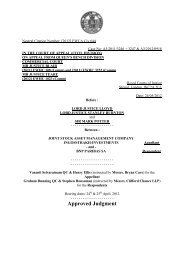The combination of policy over-ambition forthe role of education and under-ambition forunderlying economic and labour market factorssuggests the need to start afresh, rather thantweak or revise the policy legacy of the recent past.The need for radical re-thinking is clear. Besidesthe very significant failings outlined above, thelikely future state of the public finances almostinevitably rules out a return to the status quoanti through a re-run of New Labour’s attemptsto generate a ‘skills revolution’ through publiclyfunded education and training.So what’s the answer?If there is a desire for a new policy approach tothe links between education and training andthe economy and labour market that leads ina different direction from that which has gonebefore, and which deploys fresh analyses to policyformation and implementation, then the authorwould argue there are a number of relativelysimple rules that might be deployed to guidethinking:1. Develop a vision of the kind of society,economy and labour market you would liketo see our country have in 10 to 15 years’time, and then work back from that in orderto determine what kinds of policies might beneeded to deliver this vision, and what stagesof development might be needed to be gonethrough on the journey towards that vision.Notions of the Good Society need to extendbeyond education into the economy andlabour market if they are to have any chanceof generating lasting change and success.2. Avoid the trap of thinking that you can gofrom where we are now to where you wantto be in one giant step. The history of Englisheducation and training policy (and manyother areas of policy) over the last 30 yearsis littered with instances of policy-makersannouncing that ‘this is the moment’ whena step change in outcomes will commence.The chief result has been subsequent disappointment.3. Be realistic about what the education andtraining system can and cannot be expectedto do to help achieve this vision, both actingon its own and in connection with other areasof policy development and activity. Paintingeducation and training as a universal ‘cure-all’carries a huge price for education and trainingproviders (though one not usually paid bysenior policy-makers) and often displacespolicy attention and political resourcesfrom areas that need to be addressed beforeeducation and training can contribute muchto further progress.4. Recognise that education and training fulfilsmany roles, only some of which are to dowith employment and the economy, and thatmaintaining a balance of policy priority andresources between objectives to do with socialand societal outcomes, economic gain andlearning for its own sake is vitally important.There are many wider social, political andcultural goals that education policy needs toaddress, not least the notion of learning asa good in its own right and as a part of individualand collective development and theenrichment of life. It is extremely importantthat whatever priority is afforded to education’srole within economic life, its potentialcontributions to other needs and goals are notdisplaced as a result.5. Be clear about the linkages between educationand training policy and other strands ofpolicy development and think through howarticulation between these different areascan be achieved. For instance, the failure tojoin up the economic aspects of educationand training policy and investment withpolicies on economic development, businessimprovement, innovation (in its widestsense), employment and productivity hasbeen one of the key reasons why publicinvestment has not reaped the dividends thathave been expected; and why the supply of,demand for and productive utilisation ofskills have all fallen short of what has beendesired. 5 Improving education works best inthe context of more and better employment,firms that are ambitious in how and withwhom they choose to compete, and forms ofwork organisation and job design that seekto maximise skill usage to productive effect.Quality education for quality jobs makes agreat deal more sense than quality educationfor rubbish jobs!5 Ewart Keep, Ken Mayhew andJoan Payne, ‘From skills revolutionto productivity miracle – notas easy as it sounds?’, OxfordReview of Economic Policy, 22(4),pp.539–59, 2006.Education for the good society | 51
6. Remember that many of the outcomes thatcurrently disappoint within the education andtraining system are often, at least in part, theresult of structures and incentives that residewithin the labour market, and the patterns ofdemand and reward for skills that it creates.At present, almost a quarter of all jobs in ourlabour market are low paid (less than twothirdsmedian wage) and this rises to aboutone-third for female employees. Upskillingthe workforce will not, of itself, magic thiswork away. Unless and until reform starts toimpact on these jobs and the employers whocreate them, and to increase underlying levelsof demand for skill, incentives to learn willoften be weak, patchy and limited.7. Remember also that within a labour marketwhere good job opportunities are finite anda society where strong class structure stillpertains, education is constantly trying tomeet the diametrically opposing needs of twodifferent constituencies. On the one hand, itis supposed to be increasing opportunitiesfor social mobility for those at the bottomof the class structure, while at the sametime certain institutions (particularly privateschools, but also many state secondary institutionswith a largely upper middle classintake) exist to ensure that their studentsgain a disproportionate access to the elitehigher education institutions that in turntend to be the route into many of the ‘bestjobs’. These objectives are mutually exclusive.In other words, education exists within onerhetorical tradition to contest current classstructures, while also being part of anothertradition (possibly the stronger at present)that measures its success through its abilityto reproduce existing patterns of advantage.Progress is only liable to be achieved if thereis reform within education and also withinthe labour market. This means the number ofgood jobs needs to grow more rapidly (whichit is not at present), and the gap between goodand bad jobs needs to be reduced so that theconsequences of not achieving elite employmentare smaller. 6 At the same time, governmentand wider society need to acknowledgeand accept responsibility for the problemof competition for a finite supply of goodjobs rather than leaving the responsibilityfor resolving this up to individual educationand training institutions, some of whichcurrently have no moral or material incentiveto support egalitarian objectives – e.g. publicschools.Final thoughtsThe official discourse around English educationand training policy has not moved a very greatdistance in the last 30 years. Unfortunately,nearly all of the problems that could be solvedby a simple, publicly funded, supply-led strategyhave now been solved, and what remain are aset of complex problems whose roots largelylie outside the education and training systemand are imbedded in the ways UK businesseschoose to compete, deploy and reward theirworkers, and how the labour market structuresand apportions opportunities. Unless and untilpolicy analysis and resultant policy action movesforward to embrace these broader issues, theroom for progress will be very limited indeed.A Good Society requires not merely a particularkind of education and education system, but alsoa particular kind of labour market and economy.6 John Goldthorpe and MichelleJackson, ‘Intergenerational classmobility in contemporary Britain:political concerns and empiricalfindings’, British Journal of Sociology,58, pp.526–46, 2007.52 | www.compassonline.org.uk
- Page 1 and 2: Educationfor theGoodSocietyThe valu
- Page 3 and 4: Acknowledgements:Compass would like
- Page 5 and 6: ContributorsLisa Nandy is Labour MP
- Page 7 and 8: IntroductionEducation for the Good
- Page 9 and 10: 1 This article has been developedou
- Page 11 and 12: 8 See Ann Hodgson, Ken Spoursand Ma
- Page 13 and 14: 13 The most comprehensiverecent res
- Page 15 and 16: 1 See for example B. Simon, ‘Cane
- Page 17 and 18: 10 J. Martin, Making Socialists: Ma
- Page 19 and 20: the poorest homes (as measured by e
- Page 21 and 22: 1 In 2008, 15 per cent ofacademies
- Page 23 and 24: 1 Angela McRobbie, The Aftermathof
- Page 25 and 26: 8 Christine Skelton, Schooling theB
- Page 27 and 28: 1 See www.education.gov.uk/b0065507
- Page 29 and 30: 13 Barbara Fredrickson, ‘Therole
- Page 31 and 32: 6. Education forsustainabilityTeres
- Page 33 and 34: well as cognitively. Real understan
- Page 35 and 36: 7. Schools fordemocracyMichael Fiel
- Page 37 and 38: and joyful relations between person
- Page 39 and 40: 8 Wilfred Carr and AnthonyHartnett,
- Page 41 and 42: 1 Winston Churchill, quoted inNIACE
- Page 43 and 44: 9 See http://news.bbc.co.uk/1/hi/ed
- Page 45 and 46: 1 The Learning Age: A Renaissancefo
- Page 47 and 48: nities, and not have the public-pri
- Page 49 and 50: 4 Engineering flexibility: a system
- Page 51: other countries to require their re
- Page 55 and 56: 2 Adrian Elliott, State SchoolsSinc
- Page 57 and 58: 4 Peter Hyman, ‘Fear on the front
- Page 59 and 60: 12. Rethinking thecomprehensive ide
- Page 61 and 62: training, be part of a local system
- Page 64: About CompassCompass is the democra





![[2012] UKUT 399 (TCC)](https://img.yumpu.com/51352289/1/184x260/2012-ukut-399-tcc.jpg?quality=85)





![Neutral Citation Number: [2009] EWHC 3198 (Ch) Case No: CH ...](https://img.yumpu.com/50120201/1/184x260/neutral-citation-number-2009-ewhc-3198-ch-case-no-ch-.jpg?quality=85)




